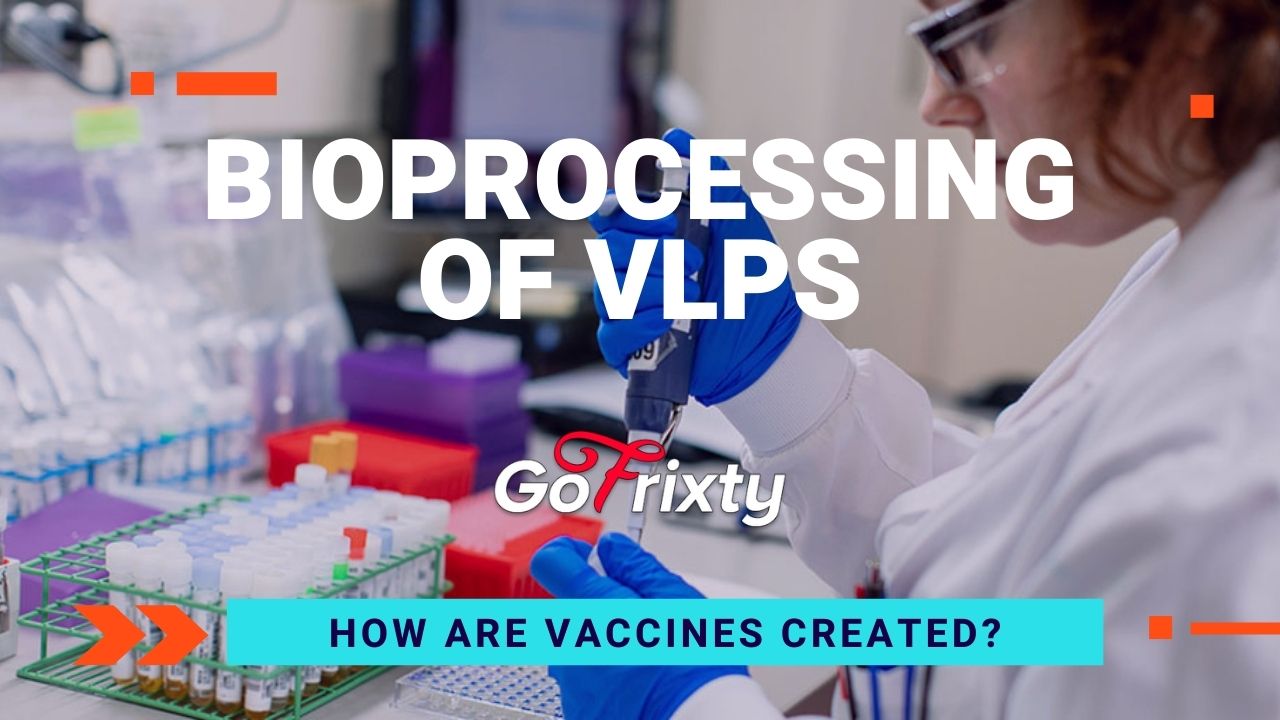History of VLPs: (As compounds of advanced vaccine Strategies)
Bioprocessing of VLPs | Gofrixty | Previous to 1969 anti-viral vaccines were either derived from inactivated viruses such as rabies vaccine, attenuated strains of pathogenic wild type viruses such as (yellow fever or poliovirus) or they were using non-pathogenic viral strains to persuade a defending immune response against pathogen family members like a vaccine of smallpox containing harmless vaccinia virus. Since then particles based on HBsAg were firstly revealed in the blood samples of patients infected with HBV and soon were developed into an intoxicating vaccine against similar viral infections.
Subviral particles have hurriedly found their way into present concepts of vaccine design. This unique nature of virus-like particles presents an inbuilt benefit over soluble antigens. They have the potential of stimulating innate and adaptive immune responses. These soluble antigens have been shown to be unsuccessful in many vaccine approaches due to feeble immunogenicity. VLPs are not harmful and do not replicate, they also embody a safer option to attenuated viruses, which have succeeded to guard against yellow polio, influenza and yellow fever virus etc.
Introduction Bioprocessing of VLPs
VLPs are greatly ordered spheres that self-assemble from virus-derived structural antigens. These are the most stable sub-viral particles that acquire exceptional adjuvant characteristics able of inducing inherent and associated immune responses. Commercially available virus-like particle-based vaccines have been very successful in protecting humans from HBV and also HPV disease. Presently VLPs are explored for their potential to combat cancer and another infectious disease.
Design of VLP has been obtained from HIV, such VLPs show potential for current AIDS approaches. Because of their exceptional characteristics, virosomes and VLPs have recently gained importance in the field of nanobiotechnology for the production of novel biomaterials. Viruses contain a protein coat that is made of many subunits and at times they are bounded by a lipid layer resulting from the cellular membranes of the host. They have developed many shapes and replication tactics in order to stay alive in the host environment. Though not all viruses contain nucleic acid which is mandatory to begin infection, virus-like particles are able to enter the target cells and they persuade host immune response from viral infection.
This experience has been profoundly described for those cells which were infected with HBV, that mass creates empty 22 nm particles exclusively composed of small hepatitis B virus surface antigen (HBsAg). Fast-growing information of virus-like particle functions and organization combined with the actions in genetic engineering have opened multiple opportunities to develop virus-like particles for a variety of fields of molecular biology. Particularly their natural immunogenic properties make them more attractive candidates for vaccine strategies.
Immunogenic properties of VLPs:
In contrast with soluble antigens, viruses like particles are able of inducing strong cellular and humoral responses as direct immunogens. Virus-like particle size appears to be favourable for uptake by DC through endocytosis and macropinocytosis that play a vital role in activating inborn and adaptive immunity. Data shows that Gag virus-like particles per se have many immunogenic epitopes that are able of stimulating cellular immunity through both, the MHC class-I and MHC class II pathways.
Due to the cyclical particle arrangement, uptake of a single virus-like particle supplies thousands of contained epitopes into the processing and presentation machinery of APCs. This method is thought to be supported by the lipid nature of virus-like particles. All these statements with new findings that pseudotyping of virus-like particles with envelope proteins like VSV-G, thus improving uptake by receptor-dependent fusion, increase epitope presentation through the exogenous MHC class-I pathway and successive CTL induction.
In my opinion, all well-known VLPs are confirmed to be strong stimulators of inborn immunity. An extensive prospective of VLPs to activate dendritic cells by activating the expansion of many populations of immune cells in vivo has just been assiduously signalled. The development of such a vaccine has many safety concerns in view of the associated regulatory complications. Fighting the well-known viruses such as HPV, HBV, etc are continually being carried over to recently rising viral diseases, for which virus-like particle-based tactics serve as first tryout tools to make a defensive vaccine.
Mechanisms and mode of action of VLPs
Following are the steps involved in reputed mechanisms of virus-like particle-mediated incentive of inherent and associated immune responses:
A) Model for the establishment of DCs by baculo-derived virus-like particle preparations. Virus-like particles are taken up by DCs through endocytosis (1) directing Ag processing in LE and appearance by the major histocompatibility complex class-II pathway, or through receptor-mediated fusion carried out by gp64 (2b) results in proteasomal Ag processing in the cytoplasm and following presentation on MHC class-II. Baculoviruses are taken up via gp64-mediated fusion (2b).
Hazardous signals from CpG-rich BV-DNA are accepted by endosomal TLR9 and transmitted by means of a MyD88-dependent or self-regulating signalling pathway which results in activation of transcription and production of inflammatory cytokines and type 1 interferon. A toll-like receptor 9-independent path of DNA detection inducing the production of IFN. Furthermore, baculovirus-derived apparatus other than DNA might leads to activation of the dendritic cells. Golgi apparatus, endoplasmic reticulum, nucleus, TV act as transport vesicles.
B) It shows the VLP-mediated maturation of dendritic cells. Uptake of virus-like particle/baculovirus activates DC through danger signals and these results in up-regulation of dendritic cell maturation markers. Mature dendritic cells present virus-like particle-derived Ag to immature CD4+ and CD8+ T cells through MHC class-I and class-II. The discharge of cytokines by dendritic cells stimulates segregation into B and T effector cells result in the release of antibody cytotoxic T cell response.

VLP vaccine production
The demands for an elevated yield of the HBsAg-based subviral vaccine than those recovered from samples of blood soon crooked towards other more proficient construction systems utilizing the possibilities of recombinant DNA machinery. By asset of HBsAg to self-assemble into particulate structures, respective particles were proficiently released from recombinant yeast cells permitting high-yield manufacture and safer purification of the vaccine. Other systems have been oppressed for virus-like particle expression, apart from yeast spheroplasts.
Keep Reading:
- What is Universal Health Coverage?
- What is health system?
- What is pooled risk in terms of healthcare insurance system?
- 4 helpful tips to avoid toxic people in your life in 2021
- Tuberculosis in Pakistan and its impact on an individual’s life
- Biofloc fish farming in Pakistan
Watch Our Latest Videos:
- Naila Shamal | Bride from Mardan demanded Rs 100k worth of books in Haq Mehr
- Top 10 places to visit in Islamabad this year
The most widespread systems include the vaccinia virus expression system, infection of insect cells with recombinant baculovirus, or transfection of RNA- and codon-optimised DNA into mammalian cells VLPs planned for mucosal vaccination can also be proficiently formed in the gut bacteria such as greatly attenuated Salmonella or Lactobacillus strains. As well, plants like potatoes or tomatoes offer a well-organized and cheap method for virus-like protein production by infection with plant viruses like tobacco mosaic virus. It is remarkable that virus-like particles assembled from HPV major capsid protein L1 in yeast were competent in inducing defensive immune responses against HPV subtypes 16 and 18 cause cervical cancer in humans. Thus resulting in a safe, well endured an extremely immunogenic vaccine that received consent for marketing in 2006. A challenging product formed in the baculo-expression system has been permitted recently.
Steps of production
A) Shows the diagrammatic presentation of a VLP made up of self-assembled virus capsid proteins that are engulfed by lipid-membrane derived from host cell with cellular incorporated cellular protein; also arbitrary packaging of cellular nucleic acid is shown.
B) Vector build is used to express chimeric HIV virus-like particles, top: virus-like particles gathered from Gag or Gag-pol proteins present endogenous epitopes; extra foreign epitopes can either be inserted (yellow box); middle: VLP-display of integrated envelope proteins by co-expression of either autologous (gp120/gp41) or heterologous (e.g. gp64) envelopes, the later resulting in pseudotyping; bottom: co-stimulatory molecules (CD40L) can be fastened on virus-like particles through a transmembrane domain (TM); Cy, cytoplasmic domain.
C) Production of virus-like particles in various expression systems. Left: infection of HighFiveTM insect cells with recombinant baculoviruses (BV) articulating particular capsid proteins; virus-like particles budding from insect cells carry BV gp64; right: co-transfection of mammalian 293 T cells with a gag encoding plasmid; co-expression of gp64 results in pseudotyping of Gag VLPs. P CMV, cytomegalovirus promoter; P SV40, Simian virus 40 promoters.

VLP versus virosomes
The second class of stable spheres resembling virus-like particles and with a broad range of applications is referred to as virosomes, representing virion-like liposome-based complexes with incorporated surface glycoprotein for receptor-mediated endocytosis. Like virus-like particles, virosomes have excellent adjuvant characteristics and have been recognized for many viruses like HIV, EBV, or rabies virus either for the purpose of vaccination or for delivery of nucleic acids, or heterologous AGS.
VLPs as scaffolds in nanoparticle biotechnology
Nanoparticles principally include all particulate structures ranging between 5 and 100 nm in size. Mainly the ability of virus-derived nanostructures to assemble into highly ordered usual arrays along with their propensity to admit a spacious range of chemical modifications has offered new views for the usage of virus-like particles in manifold biotechnological methods.
CPMV was also shown to competently self-assemble into monolayer at perfluorodecalin– water interfaces, which can be cross-linked to form a strong membrane. TMV resultant capsid protein has been confirmed to be an appropriate scaffold for widespread chemical amendments allowing assembly of nano biopolymers.
Similarly, the TMV resultant capsid protein has been verified to be an appropriate scaffold for widespread chemical adaptation allowing assemblage of nano biopolymers. So far another study has described the usage of recombinant M13 phage particles as organic templates to polymerize nanowires as building blocks for semiconductors. In these entire advances, chemically modified virus-like particles sustained their structural reliability that is a precondition for virus-like particles to succeed in the future world of nanoscience.
Future prospects:
On the basis of their elasticity and stability, simple construction and unique immunogenic characteristics, virus-like particles offer huge chances of application in the fields of vaccine development, nanobiotechnology and gene therapy.
A lot of lessons have been learned from Virus-like particle-based technologies, which will surely find themselves tackled by new challenges in the future, such as the requirement for innovative effective vaccines for recently emerging diseases. In this light, it emerges more or less sarcastic that viruses may serve up a good idea in the biotechnological era exploiting their weapons and striking them at their own game.
At present, there is no certified congenital human cytomegalovirus vaccine, but development toward this purpose has been made in the current clinical examination. A recombinant HCMV glycoprotein B (gB) vaccine has been exposed to have some efficiency in avoidance of infection in teenagers and young women and has presented an advantage to HCMV-seronegative solid organ transplant recipients.





[…] Bioprocessing of VLPs used in vaccine production […]
[…] Bioprocessing of VLPs used in vaccine production […]